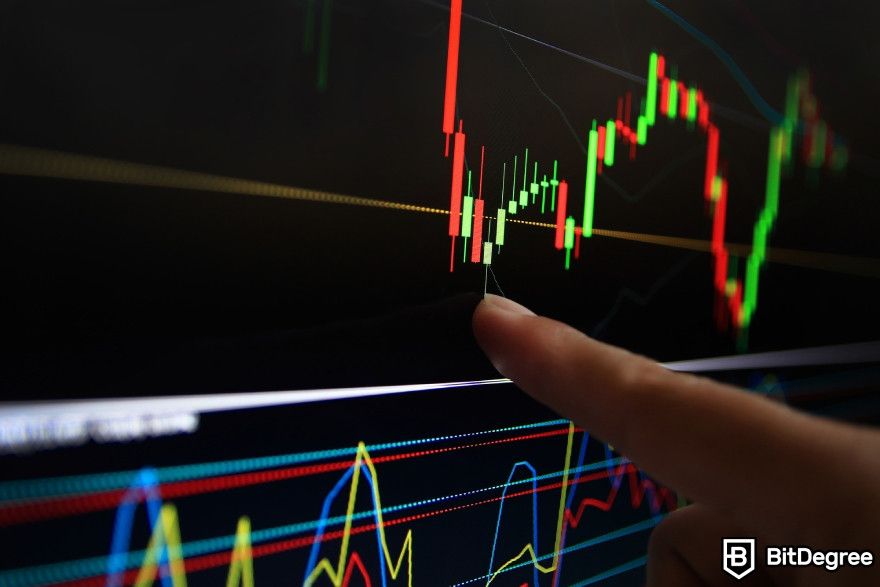Key Takeaways
- Crypto fundamental analysis provides valuable insights into the potential and value of cryptocurrencies, considering factors such as team expertise, technology, market opportunity, tokenomics, and more;
- Combining fundamental analysis with other forms of analysis and staying informed about industry developments enhances decision-making in the dynamic cryptocurrency market;
- Some of the limitations of fundamental analysis include limited data availability, market volatility, subjectivity, and regulatory uncertainties.
Stop overpaying - start transferring money with Ogvio. Sign up, invite friends & grab Rewards now! 🎁
In the realm of cryptocurrencies, where blockchain technology has transformed the financial landscape, one of the most crucial skills you should have is knowing how to employ crypto fundamental analysis. This approach involves examining the fundamental aspects of cryptocurrencies to gain valuable insights into their intrinsic value, future prospects, and potential risks.
Ultimately, this analytical view empowers traders to make well-rounded investment decisions across platforms like Binance, Bybit, and Kraken, as it enables them to evaluate overall market sentiment and the potential value of a specific asset. That said, let's explore what is fundamental analysis at its core.

Did you know?
Subscribe - We publish new crypto explainer videos every week!
Is Decentralized Anonymous Blockchain a Myth? (Explained!)


Table of Contents
- 1. What is Fundamental Analysis?
- 1.1. Fundamental Analysis VS Technical Analysis
- 2. What is Crypto Fundamental Analysis?
- 2.1. Crypto Fundamental Analysis VS Stocks Fundamental Analysis
- 2.2. Crypto Fundamental Analysis VS Forex Fundamental Analysis
- 3. How to Perform Crypto Fundamental Analysis?
- 3.1. Crypto Fundamental Analysis Tools
- 3.2. Crypto Fundamental Analysis Example: Bitcoin
- 4. Limitations of Crypto Fundamental Analysis
- 5. Conclusions
What is Fundamental Analysis?
Even though our main focus is crypto fundamental analysis, firstly, it is a must to answer the question of what is fundamental analysis in finance overall.
Latest Deal Active Right Now:Fundamental analysis is a method used to evaluate the intrinsic value of a financial asset, such as stocks, bonds, or commodities[1]. It is one of the two primary methods of analyzing investments, with the other being technical analysis.
The following are the key elements that should be kept in mind whenever the question “What is fundamental analysis?” is raised:
- Financial Statements. Analyzing an asset's financial statements, including balance sheets, income statements, and cash flow statements, provides insights into its financial health and performance. Key metrics and ratios like revenue growth, profitability, debt levels, and cash flow help gauge stability, profitability, and growth potential.
- Economic and Industry Analysis. Fundamental analysis considers broader economic conditions and industry dynamics. Analyzing indicators like GDP growth, inflation rates, and interest rates helps evaluate the asset's response to the environment. Assessing the industry's market size, competition, technology, and regulations provides context for risk and opportunity evaluation.
- Management and Leadership Evaluation. It is crucial to assess the competence and effectiveness of a company's management team. Analyzing expertise, experience, track record, strategic vision, and adaptability helps evaluate long-term growth and sustainable performance potential.
- Competitive Positioning. Understanding the asset's competitive landscape is vital, too. Evaluating market share, competitive advantages, unique selling propositions, and barriers to entry helps gauge market position and resilience against the competition.
- Regulatory and Legal Factors. It is important to consider the legal and regulatory environment. Understanding regulations, compliance requirements, and legal risks helps assess the asset's long-term viability and adaptability to changing landscapes.
So, these are all the parts that encompass the essence of what is fundamental analysis. However, this is not the only type of analysis there is – I'm sure you’ve heard the term “technical analysis” once or twice as well. But what is the difference between fundamental and technical analysis? Well, let’s see.
Fundamental Analysis VS Technical Analysis
The difference between fundamental and technical analysis starts in their focus, time horizon, sources of information, tools used, approach to value, and also the main factors that are considered to differ between them.
Let's dive deeper into fundamental analysis vs technical analysis to understand the nuance of both of these approaches.
Fundamental analysis evaluates an asset's intrinsic value and long-term prospects by considering financial statements, economic conditions, industry trends, and management quality. It takes a long-term perspective and aims to identify investments with growth potential based on fundamentals.
Technical analysis, on the other hand, studies historical price patterns, trends, and trading volumes. It focuses on short-term trading opportunities by analyzing charts, indicators, and patterns. It emphasizes market psychology and supply-demand dynamics.
Fundamental analysis relies on financial statements, economic data, industry research, and external factors to evaluate an asset's intrinsic value. The technical analysis primarily relies on historical price data and market-related information, believing that all relevant information is reflected in price movements.

Fundamental analysis uses financial ratios, valuation models, and qualitative assessments to evaluate an asset's fundamentals. It involves extensive research and analysis of various data sources to determine the asset's value. Technical analysis uses charts, trendlines, moving averages, and indicators to analyze price movements and identify trading opportunities.
The differences between fundamental and technical analysis can be summarized as the former focuses on long-term value and growth potential, while the latter emphasizes short-term price patterns and trading opportunities.
So, as I've mentioned before, the approaches of fundamental analysis vs technical analysis differ in their focus, time horizon, sources of information, and tools used.
Many investors utilize a combination of both to gain a more comprehensive understanding of an asset's potential. By considering the differences between fundamental and technical analysis, investors can make more informed investment decisions in the dynamic world of finance.
Having explored the concept of fundamental analysis vs technical analysis, let’s now focus on the realm of cryptocurrencies. After all, analyzing cryptocurrencies through crypto fundamental analysis provides you with unique factors and considerations.
What is Crypto Fundamental Analysis?
Crypto fundamental analysis is an approach used to evaluate cryptocurrencies by examining the underlying factors that contribute to their value and potential for growth. While similar in principle to traditional fundamental analysis, crypto fundamental analysis takes into account specific characteristics of the crypto market.
At its core, it involves assessing the fundamentals of a cryptocurrency project. This includes evaluating the technology behind the cryptocurrency and understanding its potential for innovation and disruption within various industries.
Certain metrics and indicators are always used to evaluate the viability and potential of a cryptocurrency project. These metrics offer insights into growth prospects, adoption potential, and sustainability. While they are important, they can be easily missed by the untrained eye, let’s take a quick look at them:
- Team and Development. The team behind a cryptocurrency project plays a crucial role in its success. Assessing the team's expertise, track record, and ability to execute the project's vision is vital. Additionally, evaluating the progress, updates, and roadmap of the project provides insights into its future prospects.
- Technology and Innovation. The underlying technology of a cryptocurrency (the blockchain) is a fundamental aspect to consider. Analyzing the technological features, scalability, security measures, and innovation within the project distinguishes promising cryptocurrencies from the rest. Tools like GitHub activity, code audits, and technical assessments aid in evaluating the quality and robustness of the technology.
- Tokenomics and Utility. You also need to understand the token economics and utility within a cryptocurrency ecosystem. Factors such as token distribution, token supply, token use cases, and incentives for token holders contribute to the overall value proposition.

- Market Opportunity and Competition. Assessing the market opportunity that a cryptocurrency targets is essential. Look for the problem it aims to solve, the size of the target market, and the competitive landscape.
- Adoption and Community. The level of adoption and community support is a significant factor in evaluating a cryptocurrency's potential. By analyzing factors such as user adoption, partnerships, collaborations, and community engagement, one can gather insights into the project's traction and potential future growth.
- Regulatory Environment. Evaluating the regulatory landscape surrounding cryptocurrencies is crucial for assessing risks and compliance considerations. Analyzing the legal frameworks, regulatory developments, and the project's compliance measures helps determine its sustainability in different jurisdictions.
After exploring this concept and its key metrics, let’s shift our focus to a comparative analysis between crypto and stocks fundamental analysis. While these methodologies share fundamental analysis principles, there are significant differences in their application.
Crypto Fundamental Analysis VS Stocks Fundamental Analysis
The distinctions between fundamental analysis of stocks and crypto can be distinguished by analyzing 4 key factors – market dynamics, risks, valuation techniques, and regulations.
Market Dynamics and Volatility
Cryptocurrencies are more volatile than traditional stocks due to their decentralized nature and relatively young market[2]. Factors like market sentiment, regulations, technology, and speculation drive this volatility, making it essential to consider these dynamics in crypto fundamental analysis.
Stocks, traded on regulated exchanges, generally have lower volatility. Stock fundamental analysis focuses on macroeconomic factors, company news, earnings reports, and industry trends.
Risk Considerations
Cryptocurrencies face risks such as technological vulnerabilities, security breaches, regulatory uncertainty, and market manipulation due to the rapidly evolving nature of the industry.
Stocks, however, are exposed to risks related to financial performance, industry competition, management stability, and regulatory compliance. So, its risk analysis focuses on financial statements and company-specific factors influenced by broader economic factors.
Valuation Techniques
Valuation techniques in the fundamental analysis of stocks and crypto differ due to the unique characteristics of each asset class. In stock fundamental analysis, common methods include price-to-earnings ratios, discounted cash flow, and industry comparisons to determine intrinsic value.

In crypto fundamental analysis, due to limited financial data and business models, valuation relies on network value-to-transactions ratio, token utility analysis, and comparative analysis with similar blockchain projects.
Regulatory Considerations
Cryptocurrencies operate in a rapidly evolving regulatory landscape[3], requiring analysts to stay updated on legal developments and comply with regulations like AML and KYC requirements.
Stocks, on the other hand, operate within established regulatory frameworks, making it easier for analysts to evaluate compliance and legal aspects. Fundamental analysis of stocks involves assessing regulatory filings, corporate governance, and industry-specific regulations.
Crypto fundamental analysis and the fundamental analysis of stocks share the common goal of evaluating the value and potential of assets. However, their application and evaluation criteria differ significantly due to the distinct characteristics of each asset class.
By recognizing the differences between the fundamental analysis of stocks and crypto, investors can tailor their analytical approaches and make more informed decisions.
Now, did you know that fundamental analysis can be done on the forex market, too? So, let's explore the differences between crypto fundamental analysis and forex fundamental analysis.
Crypto Fundamental Analysis VS Forex Fundamental Analysis
Crypto fundamental analysis and fundamental analysis forex traders employ have two distinct approaches for the evaluation of assets in their respective markets. While the fundamental analysis principles remain the foundation, the differences between markets introduce unique considerations and evaluation criteria.
So, what are these differences?
Market Dynamics and Volatility
Cryptocurrencies and forex differ in market dynamics and volatility. Cryptocurrencies, being quite new and decentralized, are more volatile due to factors like market sentiment, regulations, technology advancements, and speculation.
In contrast, forex is a global decentralized marketplace with lower volatility influenced by geopolitical events, economic indicators, central bank policies, and market sentiment.
Fundamental Factors
For cryptocurrencies, the fundamental analysis considers factors like blockchain technology, tokenomics, project team dynamics, community engagement, and regulatory landscape.

However, fundamental analysis forex traders employ focuses on macroeconomic indicators, interest rates, inflation rates, geopolitical stability, and monetary policies of countries.
Risk Considerations
Cryptocurrencies pose risks such as technological vulnerabilities, security breaches, regulatory uncertainty, and market manipulation.
Forex trading carries risks related to economic and political factors, exchange rate fluctuations, and unforeseen market events, which are evaluated through economic indicators, political stability, and other currency-affecting factors.
By recognizing the contrasting dynamics between both, we gain valuable insights into the distinct approaches of fundamental analysis of forex and crypto-focused markets.
That said, let's explore the practical side of crypto fundamental analysis. From gathering information to evaluating metrics, find out the strategies and techniques needed to navigate the crypto market and make informed investment decisions.
How to Perform Crypto Fundamental Analysis?
Performing crypto fundamental analysis involves a systematic approach to evaluate the value and potential of cryptocurrencies. By following this step-by-step process, you can gather essential information, assess key metrics, and make informed decisions:
Step 1: Define your investment goals. Clarify your objectives, whether for long-term holdings, short-term trading, or a specific investment strategy. This will help you focus your analysis and identify suitable cryptocurrencies.
Step 2: Gather information. Start by researching the cryptocurrency you want to analyze. Explore its website, whitepaper, and official documentation to understand its objectives, technology, and roadmap. Additionally, stay updated with news, announcements, and community discussions related to that cryptocurrency.
Step 3: Evaluate the team. Assess the expertise and track record of the team behind the cryptocurrency. Look for their qualifications, experience, and previous projects. A capable team is crucial for successfully executing the project's vision. Of course, you will not be able to do that if the team is anonymous (but that anonymity might sometimes lead to scams).

Step 4: Analyze the technology. Dive into the technological aspects of cryptocurrency. Evaluate the underlying blockchain technology, consensus mechanism, scalability solutions, and security measures. Consider factors like network activity, code audits, and the frequency of updates to gauge the technical robustness.
Step 5: Assess the market opportunity. Evaluate the target market and the problem the cryptocurrency aims to solve. Analyze the size of the market, competition, and potential for adoption. Look for unique selling points and advantages that differentiate the cryptocurrency from its competitors.
Step 6: Study tokenomics and utility. Understand the token economics and utility within the cryptocurrency ecosystem. Assess factors such as token distribution, token supply, token use cases, and incentives for token holders. Evaluate how the token's value may be appreciated based on its utility and demand.
Step 7: Review financials (if possible). If the cryptocurrency has a financial aspect, such as staking or lending, review the financial metrics. Consider factors like revenue models, token issuance, and financial transparency to gauge the financial viability of the project.

Step 8: Monitor regulatory considerations. Assess the regulatory environment surrounding the cryptocurrency. Stay informed about legal frameworks, regulatory developments, and compliance measures taken by the project. Evaluate the risks associated with regulatory changes and the project's adaptability.
Step 9: Analyze community sentiment. Consider the sentiment and engagement of the cryptocurrency community. Monitor social media platforms, forums, and dedicated community channels to gauge the level of support, enthusiasm, and engagement among users.
Step 10: Make informed decisions. After conducting a comprehensive analysis, use the gathered insights to make informed investment decisions. Assess the risk-reward ratio, align your analysis with your investment goals, and consider diversification strategies.
But which fundamental analysis tools should you use to employ this analysis?
Crypto Fundamental Analysis Tools
The process of crypto fundamental analysis involves various tools and resources that can greatly enhance the analytical process and provide valuable insights. These tools help investors and analysts gather relevant data, and track market trends. Here are some key tools and resources to consider:
News Aggregators
Keeping up with the latest news and developments in the crypto industry is crucial for effective fundamental analysis. News aggregators provide a centralized platform to stay updated on market trends and project updates.
Crypto Trackers
Tools like the BitDegree crypto tracker provide comprehensive data on cryptocurrencies, including price movements, market capitalization, trading volumes, historical data, and basic project details. Such tools allow users to filter and compare cryptocurrencies based on various criteria, aiding in the analysis process.
Social Listening Tools
Social listening tools gather and analyze data from various social media platforms, tracking sentiment, mentions, and discussions related to cryptocurrencies (you can find that on the BitDegree crypto tracker, too). These social signals provide sentiment indicators, social volume trends, and real-time social insights, helping analysts gauge market sentiment and community engagement.

Blockchain Explorers
Blockchain explorers allow users to explore and analyze blockchain transactions, addresses, and smart contracts. They provide transparency and visibility into cryptocurrencies' on-chain activities, enabling analysts to assess transaction volumes, network congestion, and token movement.
Community Forums and Social Media
Engaging with the crypto community on platforms like Reddit, Twitter, and Telegram can provide valuable insights and firsthand information about specific cryptocurrencies. These platforms serve as forums for discussions, project updates, and insights from industry experts and enthusiasts.
Fundamental Analysis Websites and Reports
Several websites and research companies specialize in crypto fundamental analysis, offering detailed reports, analysis, and investment insights. These sources provide comprehensive coverage of cryptocurrencies, including project evaluations, financial analysis, and market trends.
Now that you know how to make crypto fundamental analysis and which tools to use, let me give you a fundamental analysis example.

Did you know?
Subscribe - We publish new crypto explainer videos every week!
What Are Flash Loans? TOP Ways to Make Passive Income Explained



- Secure and reliable
- Accepts fiat currencies
- Lots of trading options
- Reputable exchange
- Accepts fiat currencies
- Offers various trading options

- Huge trading variety
- Regulation-compliant around the globe
- Fair trading fees
- Beginner-friendly
- A wide array of features
- Vast number of different crypto coins & tokens

- Beginner-friendly
- Secure
- Decent trading and withdrawal fees
- Crypto.com Visa Card
- Automated tools & bots
- Ecosystem synergy with CRO
Crypto Fundamental Analysis Example: Bitcoin
I'll use Bitcoin for this fundamental analysis example:
Understanding the Project
Bitcoin is the first successful and most well-known cryptocurrency, created by an unknown person or group under the pseudonym Satoshi Nakamoto. Bitcoin aims to serve as a decentralized digital currency that enables peer-to-peer transactions without the need for intermediaries like banks.
Team and Development
Bitcoin's development is open-source and maintained by a decentralized community of developers from around the world. While its creator, Satoshi Nakamoto, remains anonymous, the community's ongoing development has led to regular updates and improvements to the protocol.
Technology and Security
Bitcoin's underlying technology is built on the blockchain, which records all transactions in a transparent and immutable manner. Security has been robust over the years, as it has the longest-running network.

Community and Social Presence
Bitcoin has one of the most extensive and active communities in the cryptocurrency space. It has a strong presence on various social media platforms, forums, and conferences, with many advocates and supporters.
Use Case and Adoption
The primary use case is serving as a store of value and a medium of exchange. It has gained adoption for remittances, international money transfers, and as a hedge against inflation and economic uncertainties. Many argue that Bitcoin is the digital gold[4].
Partnerships and Collaborations
Bitcoin does not rely on traditional partnerships or collaborations like some other cryptocurrencies. Its decentralized nature means that it operates independently of companies or entities.
Market Trends and Competition
As of writing, Bitcoin remains the dominant cryptocurrency with the highest market capitalization, liquidity, and trading volumes.
Tokenomics
Bitcoin's total supply is capped at 21 million coins, making it a deflationary asset. The block reward is halved approximately every four years in a process known as the halving, reducing the rate of new supply issuance over time.

Financials and Funding
Bitcoin's development is self-sustaining, driven by its community of developers and miners who validate transactions and secure the network. There is no central company or entity responsible for funding its development.
Regulatory Environment
The regulatory landscape varies from country to country. Some nations have even embraced it as a legal tender, while others have imposed restrictions or outright bans on its use. The regulatory environment continues to evolve globally.
News and Events
Bitcoin is often impacted by significant news events, such as regulatory developments, institutional adoptions, macroeconomic trends, and technological advancements.
All in all, the insights of the fundamental analysis example of Bitcoin enable you to identify investment opportunities with strong fundamentals, assess growth potential, and make better-informed decisions.
However, there are some limitations of crypto fundamental analysis that you should be aware, too.
Limitations of Crypto Fundamental Analysis
While crypto fundamental analysis provides valuable insights, it is important to recognize its inherent limitations. Here are some key considerations to keep in mind:
- Limited Data Availability. One challenge is the availability and accuracy of data in the cryptocurrency market. Information gaps or unreliable sources can affect the accuracy and completeness of your analysis.
- Market Volatility. Cryptocurrency markets are highly volatile, making it challenging to predict future prices based solely on fundamental analysis. External factors, market sentiment, and speculative trading can overshadow fundamental factors.
- Subjectivity and Bias. Personal biases, investor sentiment, or undue influence can impact the analysis and potentially skew conclusions.

- Regulatory Uncertainty. The regulatory landscape for cryptocurrencies is evolving, leading to uncertainty. Regulatory changes or government actions can significantly impact the value and prospects of a cryptocurrency, making long-term assessments challenging.
- Emerging Technology Risks. Cryptocurrencies rely on emerging technologies that may face technical challenges, scalability issues, or security vulnerabilities. Assessing the risks associated with novel technologies requires careful consideration.
- Market Inefficiencies. The cryptocurrency market is still relatively young and can exhibit inefficiencies, such as information asymmetry and market manipulation. These factors can distort the perceived value of cryptocurrencies and impact investment decisions.
- Long-Term Predictability. Accurately predicting long-term price movements can be challenging. Market trends, adoption rates, and competitive dynamics can positively influence future performance.
By acknowledging these limitations and risks, you can approach the crypto fundamental analysis with a critical mindset and adapt your strategies accordingly. Understanding the broader market dynamics and staying informed about industry developments will help mitigate potential pitfalls and enhance your decision-making process.
Conclusions
To sum up, crypto fundamental analysis is a powerful tool for investors seeking to navigate the dynamic cryptocurrency market. By evaluating key factors such as team expertise, technology, market opportunity, and tokenomics, the fundamental analysis provides valuable insights into a cryptocurrency's potential.
Whether you're trading on popular exchanges like Binance, Bybit, or Kraken, understanding the fundamentals of crypto is essential for making investment decisions. However, it's crucial to acknowledge the limitations of crypto fundamental analysis, including limited data availability, market volatility, subjectivity, and regulatory uncertainties.
Nevertheless, by combining fundamental analysis with other forms of analysis and staying informed about industry developments, you can make better trading decisions and mitigate pitfalls.
The content published on this website is not aimed to give any kind of financial, investment, trading, or any other form of advice. BitDegree.org does not endorse or suggest you to buy, sell or hold any kind of cryptocurrency. Before making financial investment decisions, do consult your financial advisor.
Scientific References
1. S. Baresa, S. Bogdan, Z. Ivanovic: 'Strategy of Stock Valuation by Fundamental Analysis';
2. J. Wang, F. Ma, E. Bouri, et al.: 'Which Factors Drive Bitcoin Volatility: Macroeconomic, Technical, or Both?'.
3. V. Modi: 'The Regulatory Landscape of Cryptocurrencies - A Comprehensive Overview';
4. D.G. Baur, J.R. Karlsen, L.A. Smales: 'Digging Deeper - Is Bitcoin Digital Gold? A Mining Perspective'.









